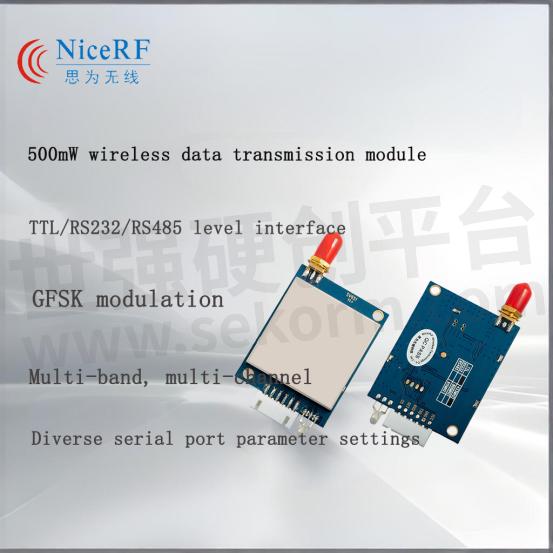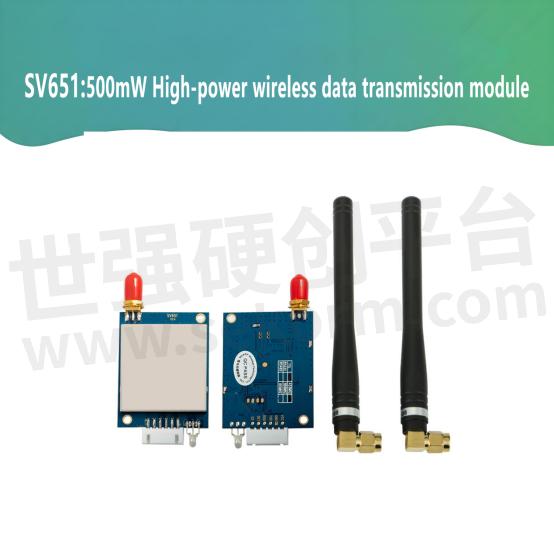Efficient Transparent Transmission and Stable Communication - Functions and Applications of the SV651 Module

SV651 is an Industrial class & highly-integrated RF module. TTL / 232 /485 can be chosen corresponding to SV651-TTL / SV651-232 / SV651-485. SV651 has good sensitivity and 500mW output power to achieve long RF range and reliable RF communication. To avoid interference, SV651 provides 40 frequency channels and a configurable Net ID. SV651 is flexible but easy to use, it comes with many parameters, such as frequency, data rate, output power, Net ID, and Node ID. Users can configure the parameters through a PC or the customer’s own device.
Core Features of the SV651 Wireless Transparent Transmission Module
Frequency Band Flexibility:
Supports multiple frequency bands including 433 MHz, 470 MHz, 868 MHz, and 915 MHz.Customizable to meet specific application needs of the user.
High Anti-Interference:
Built-in anti-interference mechanisms effectively resist electromagnetic and other wireless signal interferences.Ensures the stability and reliability of communication.
Long-Distance Transmission:
Capable of transmitting up to 2800 meters in open environments. Especially excels in long-distance and penetration capability at low data rates (1.2Kbps), making it suitable for remote wireless communication needs.
Built-in Software Watchdog
Equipped with the ability to automatically monitor system faults and perform reboots, this feature ensures that the module can continue to operate stably even under abnormal conditions. This enhances the module's reliability and minimizes downtime in critical applications.
Built-in Hardware Anti-Crash and Self-Reset Circuit
Designed to resist strong external interference signals, this feature ensures the stability and reliability of the module in harsh environments. It safeguards the module's performance against unexpected disruptions, maintaining consistent operation even under challenging conditions.

Data Transmission Stability
Adopting GFSK modulation mode ensures the stability and reliability of data transmission. Meanwhile, the module supports RSSI signal strength monitoring, enabling real-time signal strength monitoring to optimize data transmission.
Other Features of the SV651 Wireless Transparent Transmission Module
High Reliability and Stability: The module is designed with a focus on reliability, making it suitable for industrial-grade applications and ensuring long-term stable operation.
Easy Configuration: Configuration is simple and convenient, allowing users to modify serial port and RF parameters easily through PC software or online settings.
Industrial-Grade Design: Conforms to industrial-grade standards with a wide operating temperature range (-40℃ to +85℃), ensuring stable performance in various harsh environments.
Multi-Channel Support: Supports up to 40 communication channels, allowing users to select different channels for communication.
Network ID Configuration: Features a 4-byte network ID function, supporting multiple modules to work independently within the same network without interference, suitable for complex network environments and multi-node communication applications.
Wide Voltage Range: Operates within a voltage range of 4.0 to 6.5V, allowing the module to adapt to different power environments, broadening its application scope and suitability for various power supply situations.
What is Transparent Transmission? Applications of Transparent Transmission in Communication
Transparent transmission refers to the process of data transmission where the data itself is not altered, modified, or converted in any way during the transfer. In simple terms, the format and content of the signal remain unchanged after transmission.
Transparent transmission is a communication protocol that defines the format, encoding, and transmission speed of data during the transfer process. The main advantage of this protocol is that it does not interfere with or modify the data, ensuring its accuracy and thereby enhancing the reliability of data transmission.
Transparent transmission is commonly used in serial interface communications, such as serial port communication and data communication lines.
Transparent transmission has been widely applied in many fields, such as wireless communication, network communication, and the Internet of Things (IoT). It not only meets various types of data transmission needs but also effectively ensures the integrity and accuracy of the data.

What is the Process of Transparent Transmission?
Initialization and Parameter Setting
Configure the wireless module to transparent transmission mode
Data Transmission
The sender transmits the data to be sent to the wireless module via a serial port or other interfaces.
Data Packaging and Transmission
After receiving the data, the wireless module packages it into a specific frame format and transmits it to the receiving end through the wireless channel.
Data Reception and Unpacking
After the receiving wireless module receives the data frame, it automatically removes the frame format and passes the original data to the upper application through a serial port or other interfaces.
The advantages of transparent transmission are mainly reflected in the following aspects
Simplifies the development process
In transparent transmission mode, the wireless module does not process the transmitted data in any way. Developers do not need to focus on the underlying communication details and can concentrate solely on the transmission of upper-layer application data, thereby greatly simplifying the development process.
Ensure data integrity
Transparent transmission ensures data integrity and consistency, avoiding the risk of data modification or loss during the transmission process.
Improve communication efficiency
Since no additional processing of data is required, transparent transmission can reduce delays and overhead in the communication process, thereby improving communication efficiency.
High flexibility
Transparent transmission mode is suitable for various types of data transmission. Whether it is text, images, or audio and video data, it can all be transmitted through transparent transmission.
- +1 Like
- Add to Favorites
Recommend
- RF Module SV651 Application: RS485 Interface Weighting System
- What are the Advantages and Features of a Wireless Serial Module? How is a Wireless Serial Module Used?
- Differences between UART RF Module and RF Modem
- What Features Should a Portable Walkie-Talkie Module Have? Take G-NiceRF SA828 for An Example
- The Gas Meter Reading Application of RF Module RF4463Pro from G-NiceRF Saves Much Person Resource
- Advantages of G-NiceRF ASK Transmitter STX883Pro and ASK Receiver SRX883Pro in the Market
- G-NiceRF BLE5201 Module Communication Distance Testing Reaches 150m
- G-NiceRF LoRa1121 Module Newly Released: Enables Multi-Band Compatibility and Satellite Communication Functionality
This document is provided by Sekorm Platform for VIP exclusive service. The copyright is owned by Sekorm. Without authorization, any medias, websites or individual are not allowed to reprint. When authorizing the reprint, the link of www.sekorm.com must be indicated.





























































































































































































































































































































































































































































































































































































































































































































































































































































































